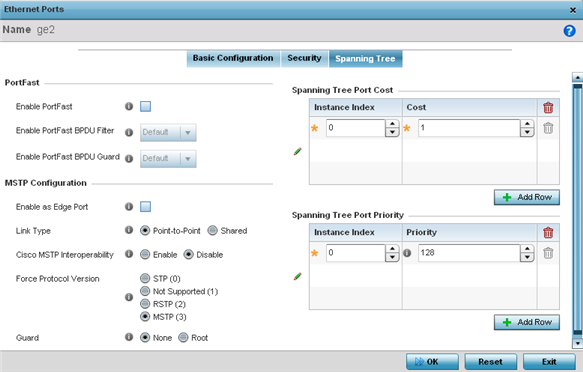To define an Ethernet port's spanning tree configuration:
Select .
The Profile screen, listing device profiles is displayed.
The selected device profile's configuration menu displays.
Expand the Interface menu and select Ethernet Ports.

|
Enable PortFast |
Select the check box to enable pull-down menus for both the Enable Portfast BPDU Filter and Enable Portfast BPDU guard options for the port. |
|
PortFast BPDU Filter |
Select enable to invoke a BPDU filter for this portfast enabled port. Enabling the BPDU filter feature ensures this PortFast enabled port does not transmit or receive BPDUs. |
|
PortFast BPDU Guard |
Select enable to invoke a BPDU guard for this portfast enabled port. Enabling the BPDU Guard feature means this portfast-enabled port will shutdown on receiving a BPDU. Thus, no BPDUs are processed. |
|
Enable as Edge Port |
Select the check box to define this port as an edge port. Using an edge (private) port, isolate devices to prevent connectivity over this port. |
|
Link Type |
Select either the Point-to-Point or Shared radio button. Selecting Point-to-Point indicates the port should be treated as connected to a point-to-point link. Selecting Shared indicates this port should be treated as having a shared connection. A port connected to a hub is on a shared link, while one the connected to a controller is a point-to-point link. |
|
Cisco MSTP Interoperability |
Select either the Enable or Disable radio buttons. This enables interoperability with Cisco's version of MSTP over the port, which is incompatible with standard MSTP. |
|
Force Protocol Version |
Sets the protocol version to either STP(0), Not Supported(1), RSTP(2) or MSTP(3). MSTP is the default setting. |
|
Guard |
Determines whether the port enforces root bridge placement. Setting the guard to Root ensures the port is a designated port. Typically, each guard root port is a designated port, unless two or more ports (within the root bridge) are connected together. If the bridge receives superior (BPDUs) on a guard root-enabled port, the guard root moves the port to a root-inconsistent STP state. This state is equivalent to a listening state. No data is forwarded across the port. Thus, the guard root enforces the root bridge position. |
|
Speed |
Default Path Cost |
|---|---|
|
<=100000 bits/sec |
200000000 |
|
<=1000000 bits/sec |
20000000 |
|
<=10000000 bits/sec |
2000000 |
|
<=100000000 bits/sec |
200000 |
|
<=1000000000 bits/sec |
20000 |
|
<=10000000000 bits/sec |
2000 |
|
<=100000000000 bits/sec |
200 |
|
<=1000000000000 bits/sec |
20 |
|
>1000000000000 bits/sec |
2 |
Define an Instance Index using the spinner control and assign a Priority value. The lower the priority, a greater likelihood of the port becoming a designated port. Thus applying an higher value impacts the port's likelihood of becoming a designated port.